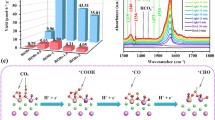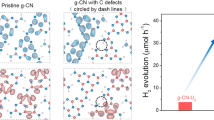Abstract
Defect engineering is an effective mean to improve the photocatalytic evolution of H2, but the increase of activity caused by a single modification method is often limited. Although the carbon vacancy plays a very important role in promoting the hydrogen evolution activity, it is easy to inactivate due to the instability of the vacancy. Precise B refilling induced by surface carbon defects can not only stabilize the carbon vacancy but also adjust the energy band structure of g-C3N4 (CN), so that B refilling carbon vacancies CN (BRf-VC-CN) shows the highest electron reduction ability. The electrochemical results show that BRf-VC-CN represent the strongest ability of carrier separation and transfer, and the large internal electric field also indicates that the enhanced interlayer electron transfer. At the same time, surface heteroatom refilling can also improve the H2O adsorption. As a result, the hydrogen evolution of the sample after B refilling is greatly increased to 18,100 μL g−1 h−1, which is 27.2 times higher than that of CN. This work will provide reliable and clear insights for the controlled defect engineering of photocatalysts, and provide general modification strategies for conventional typical heteroatoms used in H2 production.
Graphical Abstract
A defect-induced heteroatom refilling strategy is used here to synthesize B introduced in carbon nitride by precisely controlling the “introduction” sites on C1 sites. The interaction between vacancy and refilled heteroatoms makes B-refilled samples show high internal electric field strength and greatly improve the photocatalytic activity.






Similar content being viewed by others
References
Fujizhima A, Honda K (1972) Electrochemical photolysis of water at a semiconductor electrode. Nature 238:37–38
Zhang J, Liang X, Zhang C, Lin L, Xing W, Yu Z, Zhang G, Wang X (2022) Improved charge separation in poly(heptazine-triazine) imides with semi-coherent interfaces for photocatalytic hydrogen evolution. Angew Chem Int Ed 61:e2022108
Shen M, Zhang LX, Wang M, Tian JJ, Jin XX, Guo LM, Wang LZ, Shi JL (2019) Carbon-vacancy modified graphitic carbon nitride: enhanced CO2 photocatalytic reduction performance and mechanism probing. J Mater Chem A 7:1556–1563
Liu YJ, Liu HX, Zhou HM, Li TD, Zhang LN (2019) A Z-scheme mechanism of N-ZnO/g-C3N4 for enhanced H2 evolution and photocatalytic degradation. App Surf Sci 466:133–140
Tong Z, Yang D, Sun Y, Nan Y, Jiang Z (2016) Tubular g-C3N4 isotype heterojunction: enhanced visible-light photocatalytic activity through cooperative manipulation of oriented electron and hole transfer. Small 12:4093–4101
Shi L, Yang L, Zhou W, Liu Y, Yin L, Hai X, Song H, Ye J (2018) Photoassisted construction of holey defective g-C3N4 photocatalysts for efficient visible-light-driven H2O2 production. Small 14:1703142
Wang SH, Zhan JW, Chen K, Ali A, Zeng LH, Zhao H, Hu WL, Zhu LX, Xu XL (2020) Potassium-doped g-C3N4 achieving efficient visible-light-driven CO2 reduction. ACS Sustain Chem Eng 8:8214–8222
Zhao Y, Yang L, Chen S, Wang X, Ma Y, Wu Q, Jiang Y, Qian W, Hu Z (2013) Can boron and nitrogen co-doping improve oxygen reduction reaction activity of carbon nanotubes? J Am Chem Soc 135:1201–1204
Zhao DM, Wang YQ, Dong CL, Huang YC, Chen J, Xue F, Shen SH, Guo LJ (2021) Boron-doped nitrogen-deficient carbon nitride-based Z-scheme heterostructures for photocatalytic overall water splitting. Nat Energy 6:388–397
Li B, Si Y, Fang Q, Shi Y, Huang WQ, Hu W, Pan A, Fan X, Huang GF (2020) Hierarchical self-assembly of well-defined louver-like P-doped carbon nitride nanowire arrays with highly efficient hydrogen evolution. Nano-micro lett 12:52
Moon HS, Hsiao KC, Wu MC, Yun Y, Hsu YJ, Yong K (2023) Spatial separation of cocatalysts on Z-Scheme organic/inorganic heterostructure hollow spheres for enhanced photocatalytic H2 evolution and in-depth analysis of the charge-transfer mechanism. Adv Mater 35:e2200172
Li CM, Du YH, Wang DP, Yin SM, Tu WG, Chen Z, Kraft M, Chen G, Xu R (2017) Unique P-Co-N surface bonding states constructed on g-C3N4 nanosheets for drastically enhanced photocatalytic activity of H2 evolution. Adv Funct Mater 27:160432
Liu QQ, Shen JY, Yu XH, Yang XF, Liu W, Yang J, Tang H, XuH LHM, Li YY, Xu JS (2019) Unveiling the origin of boosted photocatalytic hydrogen evolution in simultaneously (S, P, O)-Codoped and exfoliated ultrathin g-C3N4 nanosheets. Appl Catal B: Environ 248:84–94
Lv SJ, Hau NY, Zhu RX, Li S, Wu CX, Liu YX, Zhang YF, Jing L, Deng JG, Dai HX (2021) Phosphorus vapor assisted preparation of P-doped ultrathin hollow g-C3N4 sphere for efficient solar-to-hydrogen conversion. Appl Catal B: Environ 297:120438
Liu G, Niu P, Sun CH, Smith SC, Chen ZG, Lu GQ, Cheng HM (2010) Unique electronic structure induced high photoreactivity of sulfur-doped graphitic C3N4. J Am Chem Soc 132:11642–11648
Niu P, Qiao M, Li YF, Huang L, Zhai TY (2018) Distinctive defects engineering in graphitic carbon nitride for greatly extended visible light photocatalytic hydrogen evolution. Nano Energy 44:73–81
Jiao X, Chen Z, Li X, Sun Y, Gao S, Yan W, Wang C, Zhang Q, Lin Y, Luo Y, Xie Y (2017) Defect-mediated electron-hole separation in one-unit-cell ZnIn2S4 Layers for boosted solar-driven CO2 reduction. J Am Chem Soc 139:7586–7594
Bi W, Ye C, Xiao C, Tong W, Zhang X, Shao W, Xie Y (2014) Spatial location engineering of oxygen vacancies for optimized photocatalytic H2 evolution activity. Small 10:2820–2825
Yang B, Li XL, Zhang Q, Yang XD, Wan JG, Liao GF, Zhao JJ, Wang RJ, Liu JC, Rodriguez RD, Jia X (2022) Ultrathin porous carbon nitride nanosheets with well-tuned band structures via carbon vacancies and oxygen doping for significantly boosting H2 production. Appl Catal B: Environ 314:121521
Su LN, Wang PF, Ma XL, Wang JH, Zhan SH (2021) Regulating local electron density of iron single sites by introducing nitrogen vacancies. Angew Chem Int Ed 60:21261–21266
Xiao ZH, Wang Y, Huang YC, Wei ZX, Dong CL, Ma JM, Shen SH, Li YF, Wang SY (2017) Filling the oxygen vacancies in Co3O4with phosphorus: an ultra-efficient electrocatalyst for overall water splitting. Energy Environ Sci 10:2563–2569
Chu K, Li QQ, Liu YP, Wang J, Cheng YH (2020) Filling the nitrogen vacancies with sulphur dopants in graphitic C3N4 for efficient and robust electrocatalytic nitrogen reduction. Appl Catal B: Environ 267:118693
Hu C, Hu JC, Zhu ZJ, Lu Y, Chu SQ, Ma TY, Zhang YH, Huang HW (2022) Orthogonal charge transfer by precise positioning of silver single atoms and clusters. Angew Chem Int Ed 61:e202212397
Li YH, Ho W, Lv KL, Zhu BC, Lee SC (2018) Carbon vacancy-induced enhancement of the visible light-driven photocatalytic oxidation of NO over g-C3N4 nanosheets. App Surf Sci 430:380–389
Wang W, Zhang H, Zhang S, Liu Y, Wang G, Sun C, Zhao H (2019) Potassium-ion-assisted regeneration of active cyano groups in carbon nitride nanoribbons: visible-light-driven photocatalytic nitrogen reduction. Angew Chem Int Ed 58:16644–16650
Hu MH, Noda S, Okubo T, Yamaguchi Y, Komiyama H (2001) Structure and morphology of self-assembled 3-mercaptoropyltrimethoxysilane layers on silicon oxid. App Surf Sci 181:307–316
Shi WL, Shu KK, Sun HR, Ren HJ, Li MY, Chen FY, Guo F (2020) Dual enhancement of capturing photogenerated electrons by loading CoP nanoparticles on N-deficient graphitic carbon nitride for efficient photocatalytic degradation of tetracycline under visible light. Sep Purif Technol 246:116930
Colak TO, Tuc AC, Minkina VG, Shabunya SI, Sankir M, Demirci SN, Kalinin VL (2021) Efficient hydrogen generation with Co3O4@TiO2-g-C3N4 composite catalyst via catalytic NaBH4 hydrolysis. Catal Lett 152:2779–2788
Ozaki JI, Kimura N, Anahara T, Oya A (2007) Preparation and oxygen reduction activity of BN-doped carbons. Carbon 45:1847–1853
Ajmal S, Rasheed A, Tran NQ, Shao XD, Hwang Y, Bui VQ, Kim YD, Kim J, Lee H (2023) Electron deficient boron-doped amorphous carbon nitride to uphill N2 photo-fixation through π back donation. Appl Catal B: Environ 321:122070
Huang C, Wen Y, Ma J, Dong D, Shen Y, Liu S, Ma H, Zhang Y (2021) Unraveling fundamental active units in carbon nitride for photocatalytic oxidation reactions. Nat commun 12:320
Curdy C, Naik A, Kalia YN, Alberti I, Guy RH (2004) Non-invasive assessment of the effect of formulation excipients on stratum corneum barrier function in vivo. Int J pharmaceut 271:251–256
Kun Chang, Zongwei Mei, Tao Wang, Qing Kang, Shuxin Ouyang, Jinhua Ye (2014) MoS2/graphene cocatalyst for efficient photocatalytic H2 evolution under visible light irradiation. ACS nano 8(7):7078–7087
Guo S, Deng Z, Li M, Jiang B, Tian C, Pan Q, Fu H (2016) Phosphorus-doped carbon nitride tubes with a layered micro-nanostructure for enhanced visible-light photocatalytic hydrogen evolution. Angew Chem Int Ed 55:1830–1834
Tayyab M, Liu YJ, Liu ZG, Pan LH, Xu ZH, Yue WH, Zhou L, Lei JY, Zhang JL (2022) One-pot in-situ hydrothermal synthesis of ternary In2S3/Nb2O5/Nb2C Schottky/S-scheme integrated heterojunction for efficient photocatalytic hydrogen production. J Colloid Interf Sci 628:500–512
Liu YJ, Zhu QH, Tayyab M, Zhou L, Lei JY, Zhang JL (2021) Single-atom pt loaded zinc vacancies ZnO–ZnS induced Type-V electron transport for efficiency photocatalytic H2 evolution. Sol RRL 5:2100536
Tayyab M, Liu YJ, Min SX, Muhammad IR, Zhu QH, Zhou L, Lei JY, Zhang JL (2022) Simultaneous hydrogen production with the selective oxidation of benzyl alcohol to benzaldehyde by a noble-metal-free photocatalyst VC/CdS nanowires. Chinese J Catal 43:1165–1175
Yang YH, Li XL, Lu C, Huang WH (2019) G-C3N4 Nanosheets coupled with TiO2 nanosheets as 2D/2D heterojunction photocatalysts toward high photocatalytic activity for hydrogen production. Catal Lett 149:2930–2939
Wang C, Wang K, He XX, Liao Y, Mao H, Zhao SL, Ma J (2020) Constructing internal electric field in g-C3N4 significantly promotes the photocatalytic performance for H2O2 generation. Catal Lett 151:1225–1230
Han T, Cao X, Sun K, Peng Q, Ye C, Huang A, Cheong WC, Chen Z, Lin R, Zhao D, Tan X, Zhuang Z, Chen C, Wang D, Li Y (2021) Anion-exchange-mediated internal electric field for boosting photogenerated carrier separation and utilization. Nat commun 12:4952
Takashi KK, Masayuki M, Hideyuki T, Yoshihiro H, Taneo N (1990) Photoreflectance characterization of built-in potential in MBE-produced As-grown GaAs surface. Proc SPIE 56:1286
Acknowledgements
This work was supported by National Key Research and Development Program of China (2022YFB3803600), the National Natural Science Foundation of China (21972040), the Innovation Program of Shanghai Municipal Education Commission (2021-01-07-00-02-E00106), the Science and Technology Commission of Shanghai Municipality (20DZ2250400, 22230780200), and the Program of Introducing Talents of Discipline to Universities (B20031), the National Natural Science Foundation of China (22006038).
Funding
National Natural Science Foundation of China, 21972040, 22006038, Program of Introducing Talents of Discipline to Universities, B20031, Innovation Program of Shanghai Municipal Education Commission, 2021-01-07-00-02-E00106, National Key Research and Development Program of China, 2022YFB3803600, Science and Technology Commission of Shanghai Municipality, 20DZ2250400,22230780200
Author information
Authors and Affiliations
Corresponding author
Additional information
Publisher's Note
Springer Nature remains neutral with regard to jurisdictional claims in published maps and institutional affiliations.
Supplementary Information
Below is the link to the electronic supplementary material.
Rights and permissions
Springer Nature or its licensor (e.g. a society or other partner) holds exclusive rights to this article under a publishing agreement with the author(s) or other rightsholder(s); author self-archiving of the accepted manuscript version of this article is solely governed by the terms of such publishing agreement and applicable law.
About this article
Cite this article
Liu, Y., Zheng, Y., Tayyab, M. et al. Internal Electric Field Enhances B Refilling and Carbon Vacancy Double Modulation to Promote Photocatalytic Hydrogen Evolution. Catal Lett 154, 798–807 (2024). https://doi.org/10.1007/s10562-023-04346-7
Received:
Accepted:
Published:
Issue Date:
DOI: https://doi.org/10.1007/s10562-023-04346-7




